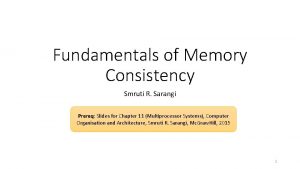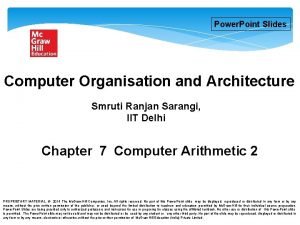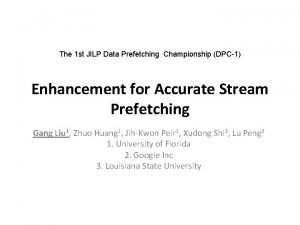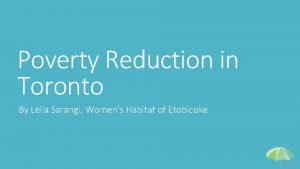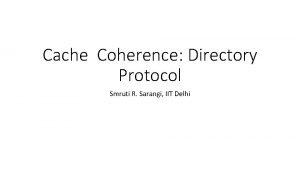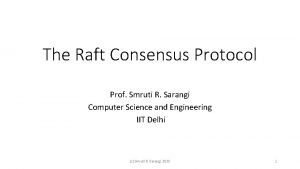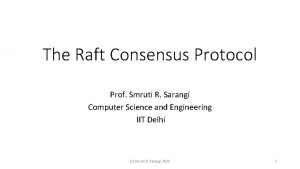Data Prefetching Smruti R Sarangi Data Prefetching Instead
















- Slides: 16

Data Prefetching Smruti R. Sarangi

Data Prefetching • Instead of instructions let us now prefetch data • Important distinction • Instructions are fetched into the in-order part of the OOO pipeline • Data is fetched into the OOO pipeline • As a result the IPC is slightly more resilient to data cache misses • Nevertheless, prefetching is useful • On the other hand • x 86 has instructions where a single instruction (with the rep prefix) can be used to load or store multiple bytes from memory • Small i-cache footprint, yet large d-cache footprint

Outline • Stride based Prefetching • Prefetching based Runahead Execution

History based Prefetching for (i = 0; i < N; i++ ) {. . . A [i] = B[i] + C[2*i]; } • Consider the following piece of code • For the arrays A and B, the addresses in each iteration differ by 4 bytes (assumed to be the size of an integer) • For the array, C, consecutive accesses differ by 8 bytes • This instruction will translate into multiple load/store RISC instruction • There will be only on memory access per instruction • The hardware will observe that for the same PC • The memory address keeps getting incremented by a certain value (4 or 8 bytes in this case) • This fixed increment is called a stride

Reference Prediction Table (RPT) Memory address Instruction Tag Previous Address Stride State PC Adder • For each instruction • keep trace of the address and the stride • You can decide to prefetch N interations in advance • State: initial transient (not sure about the stride) steady Prefetched address

Extensions • How many iterations to prefetch in advance? • This depends upon the rest of the instructions in the for loop • This ideally should be dynamically adjusted • For a subset of prefetches • Monitor the number of cycles between when a line is prefetched and it is actually used for the steady state • Should not be negative • Should be a small positive number • Extensions to the RPT scheme • Track the next address for a linked list (If p is prefetched, prefetch *(p->next))

Outline • Stride based Prefetching • Prefetching based Runahead Execution

Runahead Mode • What happens when we do bad prefetching? • We have misses. L 1 misses can more or less be taken care of by an OOO pipeline • L 2 misses are bigger problems • What happens on an L 2 miss • You go to main memory (200 -400) cycles • What does the OOO pipeline do? • The IW and ROB fill up • It pretty much stalls • Idea: Do some work during the stalled period

What can you do? • Enter runahead mode • • Return a junk value for the L 2 miss Restart execution You will produce junk values (in the forward slice) That is still okay. Why • You will prefetch data into the caches • Once when the L 2 miss returns • Flush the instructions in the forward slice of the L 2 miss • Re-execute them • Very effective prefetching technique

Operation • Before entering the runahead mode • Take a checkpoint of the architectural register file • Also, of the branch history register and return address stack • Start the runahead mode • • • Add an invalid (INV) bit to each register The L 2 miss generates an INV value All the instructions in its foward slice have an INV value The INV value is same as the poison bit (learnt earlier) Question: • Do we restrict invalid values to the pipeline or let them propagate?

Value Propagation Pipeline L 1 L 2 • If till the pipeline nullify all stores • If till the L 1 do not evict INV data from the L 1 • Preferably not till the L 2 (massive amount of state management)

Let us take INV values till the L 1 • If we use the traditional L 1 cache, there will be some problems • We need to maintain both INV and non-INV data together • What if they are on the same line (additional state required) • Solution: have an additional runahead cache that contains only INV data. Pipeline Runahead L 1

Runahead L 1 Cache • A store might have the INV flag set for two reasons • Its address is INV. Ignore. Assume that the address is correct and access the runahead cache. • A stores data is INV. Access the runahead cache • Perform the store • Let us keep some additional state per line. Let us mark those words written by an INV store as INV. Cache Line INV Stores

Loading a Value • First try forwarding in the LSQ • If not possible: • • • Access the runahead cache and L 1 cache in parallel The runahead cache gets preference Load the data. If the data is marked as INV, marked the load data as INV Otherwise, load data from the L 1 cache If there is a miss, load data from the L 2 (acts as prefetching)

Operation (Contd. . . ) • Keep fetching and retiring (in runahead mode) instructions • All the instructions before the speculated load (in program order) will retire • After that, all insts. are in runahead mode (will not retire) • As we fetch and execute more and more instructions, we in effect do more prefetching • What about updating branch predictors? • Best option: Treat runahead instructions as normal instructions • Return from runahead mode • Similar to a branch misprediction, restore the checkpoint

THE END
 Smruti sarangi
Smruti sarangi Smruti sarangi
Smruti sarangi Smruti ranjan sarangi
Smruti ranjan sarangi Data prefetching championship
Data prefetching championship Prefetching relevant priors
Prefetching relevant priors Leila sarangi
Leila sarangi Cordhophone adalah kelompok alat musik
Cordhophone adalah kelompok alat musik Why did orwell use animals instead of people
Why did orwell use animals instead of people Instead of punctuation
Instead of punctuation Why we use galvanometer instead of ammeter
Why we use galvanometer instead of ammeter Act 4 summary romeo and juliet
Act 4 summary romeo and juliet Instead of punctuation
Instead of punctuation Why did god choose moses
Why did god choose moses Adopting proven technology instead of experimental
Adopting proven technology instead of experimental Email instead of meeting
Email instead of meeting Why do cells divide? *
Why do cells divide? * Chef brigade system
Chef brigade system

